Long-Term Rainfall–Runoff Relationships During Fallow Seasons in a Humid Region
Abstract
1. Introduction
2. Materials and Methods
2.1. Study Site
2.2. DRAINMOD Description and Input Parameters
2.3. Rainfall Indices
2.4. Classifying Wet, Normal, and Dry Years
3. Results
3.1. Rainfall and Frequency During the Fallow Seasons
3.2. Rainfall Characteristics During the Fallow Seasons
3.3. Runoff Characteristics in Different Rainfall Category Years During Fallow Seasons from 1924 to 2023
3.4. Runoff Response to Different Rainfall Categories During Fallow Seasons from 1924 to 2023
3.5. Rainfall-Runoff Dynamics in Spring from 1924 to 2023
4. Discussion
4.1. Runoff–Rainfall Relationships
4.2. Interannual and Seasonal Variability in Runoff Dynamics
4.3. Impacts of Water Table Depth
4.4. Uncertainties and Limitations
5. Conclusions
Author Contributions
Funding
Data Availability Statement
Acknowledgments
Conflicts of Interest
References
- Kunkel, K.E.; Pielke, R.A., Jr.; Changnon, S.A. Temporal fluctuations in weather and climate extremes that cause economic and human health impacts: A review. Bull. Am. Meteorol. Soc. 1999, 80, 1077–1098. [Google Scholar] [CrossRef]
- Kunkel, K.E. North American trends in extreme precipitation. Nat. Hazards 2003, 29, 291–305. [Google Scholar] [CrossRef]
- Pimentel, D. Soil erosion: A food and environmental threat. Environ. Dev. Sustain. 2006, 8, 119–137. [Google Scholar] [CrossRef]
- Powell, E.J.; Keim, B.D. Trends in daily temperature and precipitation extremes for the southeastern United States: 1948–2012. J. Clim. 2015, 28, 1592–1612. [Google Scholar] [CrossRef]
- Skeeter, W.J.; Senkbeil, J.C.; Keellings, D.J. Spatial and temporal changes in the frequency and magnitude of intense precipitation events in the southeastern United States. Int. J. Climatol. 2019, 39, 768–782. [Google Scholar] [CrossRef]
- Bishop, D.A.; Williams, A.P.; Seager, R. Increased fall precipitation in the southeastern United States driven by higher-intensity, frontal precipitation. Geophys. Res. Lett. 2019, 46, 8300–8309. [Google Scholar] [CrossRef]
- Zhang, B.; Feng, G.; Read, J.J.; Kong, X.; Ouyang, Y.; Adeli, A.; Jenkins, J.N. Simulating soybean productivity under rainfed conditions for major soil types using APEX model in East Central Mississippi. Agric. Water Manag. 2016, 177, 379–391. [Google Scholar] [CrossRef]
- Keim, B.D. Preliminary analysis of the temporal patterns of heavy rainfall across the southeastern United States. Prof. Geogr. 1997, 49, 94–104. [Google Scholar] [CrossRef]
- Keim, B.D. Precipitation annual maxima as a measure of change in extreme rainfall magnitudes in the southeastern United States over the past century. Southeast. Geogr. 1999, 39, 235–245. [Google Scholar] [CrossRef]
- Assouline, S.; Selker, J.S.; Parlange, J.Y. A simple accurate method to predict time of ponding under variable intensity rainfall. Water Resour. Res. 2007, 43. [Google Scholar] [CrossRef]
- Liu, H.; Lei, T.W.; Zhao, J.; Yuan, C.P.; Fan, Y.T.; Qu, L.Q. Effects of rainfall intensity and antecedent soil water content on soil infiltrability under rainfall conditions using the run off-on-out method. J. Hydrol. 2011, 396, 24–32. [Google Scholar] [CrossRef]
- Fang, N.F.; Shi, Z.H.; Li, L.; Guo, Z.L.; Liu, Q.J.; Ai, L. The effects of rainfall regimes and land use changes on runoff and soil loss in a small mountainous watershed. Catena 2012, 99, 1–8. [Google Scholar] [CrossRef]
- Ran, Q.; Su, D.; Li, P.; He, Z. Experimental study of the impact of rainfall characteristics on runoff generation and soil erosion. J. Hydrol. 2012, 424, 99–111. [Google Scholar] [CrossRef]
- Ziadat, F.M.; Taimeh, A.Y. Effect of rainfall intensity, slope, land use and antecedent soil moisture on soil erosion in an arid environment. Land Degrad. Dev. 2013, 24, 582–590. [Google Scholar] [CrossRef]
- Kirono, D.G.; Chiew, F.H.; Kent, D.M. Identification of best predictors for forecasting seasonal rainfall and runoff in Australia. Hydrol. Process. Int. J. 2010, 24, 1237–1247. [Google Scholar] [CrossRef]
- La Torre Torres, I.B.; Amatya, D.M.; Sun, G.; Callahan, T.J. Seasonal rainfall–runoff relationships in a lowland forested watershed in the southeastern USA. Hydrol. Process. 2011, 25, 2032–2045. [Google Scholar] [CrossRef]
- Amatya, D.M.; Chescheir, G.M.; Skaggs, R.W.; Fernandez, G.P. Hydrology of poorly drained coastal watersheds in eastern North Carolina. In Proceedings of the 2002 ASAE Annual Meeting, Chicago, IL, USA, 28–31 July 2002; American Society of Agricultural and Biological Engineers: Saint Joseph, MI, USA, 2002. [Google Scholar][Green Version]
- Amatya, D.M.; Skaggs, R.W.; Blanton, C.D.; Gilliam, J.W. Hydrologic and water quality effects of harvesting and regeneration of a drained pine forest. In Hydrology and Management of Forested Wetlands, Proceedings of the International Conference, New Bern, NC, USA, 8–12 April 2006; American Society of Agricultural and Biological Engineers: Saint Joseph, MI, USA, 2006. [Google Scholar][Green Version]
- Song, S.; Wang, W. Impacts of antecedent soil moisture on the rainfall-runoff transformation process based on high-resolution observations in soil tank experiments. Water 2019, 11, 296. [Google Scholar] [CrossRef]
- Zimmermann, B.; Elsenbeer, H.; De Moraes, J.M. The influence of land-use changes on soil hydraulic properties: Implications for runoff generation. For. Ecol. Manag. 2006, 222, 29–38. [Google Scholar] [CrossRef]
- Wei, L.; Zhang, B.; Wang, M. Effects of antecedent soil moisture on runoff and soil erosion in alley cropping systems. Agric. Water Manag. 2007, 94, 54–62. [Google Scholar] [CrossRef]
- Cui, X.; Li, X. Role of surface evaporation in surface rainfall processes. J. Geophys. Res. Atmos. 2006, 111. [Google Scholar] [CrossRef]
- Elias, D.; Ierotheos, Z. Quantifying the rainfall-water level fluctuation process in a geologically complex lake catchment. Environ. Monit. Assess. 2006, 119, 491–506. [Google Scholar] [CrossRef] [PubMed]
- Kaya, Y. Evaluation of ICESat-2 Laser Altimetry for Inland Water Level Monitoring: A Case Study of Canadian Lakes. Water 2025, 17, 1098. [Google Scholar] [CrossRef]
- Maul, J.D.; Cooper, C.M. Water quality of seasonally flooded agricultural fields in Mississippi, USA. Agric. Ecosyst. Environ. 2000, 81, 171–178. [Google Scholar] [CrossRef]
- Adeli, A.; Tewolde, H.; Jenkins, J.N.; Rowe, D.E. Cover crop use for managing broiler litter applied in the fall. Agron. J. 2011, 103, 200–210. [Google Scholar] [CrossRef]
- Adeli, A.; Tewolde, H.; Shankle, M.W.; Way, T.R.; Brooks, J.P.; McLaughlin, M.R. Runoff quality from no-till cotton fertilized with broiler litter in subsurface bands. J. Environ. Qual. 2013, 42, 284–291. [Google Scholar] [CrossRef] [PubMed]
- Baker, B.H.; Czarnecki, J.P.; Omer, A.R.; Aldridge, C.A.; Kröger, R.; Prevost, J.D. Nutrient and sediment runoff from agricultural landscapes with varying suites of conservation practices in the Mississippi Alluvial Valley. J. Soil Water Conserv. 2018, 73, 75–85. [Google Scholar] [CrossRef]
- Feng, G.; Ouyang, Y.; Adeli, A.; Read, J.; Jenkins, J. Rainwater deficit and irrigation demand for row crops in Mississippi Blackland Prairie. Soil Sci. Soc. Am. J. 2018, 82, 423–435. [Google Scholar] [CrossRef]
- Skaggs, R.W.; Youssef, M.A.; Chescheir, G.M. DRAINMOD: Model use, calibration, and validation. Trans. ASABE 2012, 55, 1509–1522. [Google Scholar] [CrossRef]
- Skaggs, R.W. Drainage simulation models. Agric. Drain. 1999, 38, 469–500. [Google Scholar]
- Abduljaleel, Y.; Awad, A.; Al-Ansari, N.; Salem, A.; Negm, A.; Gabr, M.E. Assessment of subsurface drainage strategies using DRAINMOD model for sustainable agriculture: A review. Sustainability 2023, 15, 1355. [Google Scholar] [CrossRef]
- Youssef, M.A.; Liu, Y.; Chescheir, G.M.; Skaggs, R.W.; Negm, L.M. DRAINMOD modeling framework for simulating controlled drainage effect on lateral seepage from artificially drained fields. Agric. Water Manag. 2021, 254, 106944. [Google Scholar] [CrossRef]
- Ghane, E.; Askar, M.H. Predicting the effect of drain depth on profitability and hydrology of subsurface drainage systems across the eastern USA. Agric. Water Manag. 2021, 258, 107072. [Google Scholar] [CrossRef]
- Zhang, X.; Alexander, L.; Hegerl, G.C.; Jones, P.; Tank, A.K.; Peterson, T.C.; Trewin, B.; Zwiers, F.W. Indices for monitoring changes in extremes based on daily temperature and precipitation data. Wiley Interdiscip. Rev. Clim. Change 2011, 2, 851–870. [Google Scholar] [CrossRef]
- Zhang, B.; Feng, G.; Kong, X.; Lal, R.; Ouyang, Y.; Adeli, A.; Jenkins, J.N. Simulating yield potential by irrigation and yield gap of rainfed soybean using APEX model in a humid region. Agric. Water Manag. 2016, 177, 440–453. [Google Scholar] [CrossRef]
- Tang, Q.; Feng, G.; Fisher, D.; Zhang, H.; Ouyang, Y.; Adeli, A.; Jenkins, J. Rain water deficit and irrigation demand of major row crops in the Mississippi Delta. Trans. ASABE 2018, 61, 927–935. [Google Scholar] [CrossRef]
- Kunkel, K.E.; Stevens, L.E.; Stevens, S.E.; Sun, L.; Janssen, E.; Wuebbles, D.; Konrad, C.E., II; Fuhrman, C.M.; Keim, B.D.; Kruk, M.C.; et al. Regional climate trends and scenarios for the US National Climate Assessment 2013: Part 2. Climate of the Southeast US. Available online: https://www.nesdis.noaa.gov/about/documents-reports/technical-reports (accessed on 10 May 2025).
- Keim, B.D. Spatial, synoptic, and seasonal patterns of heavy rainfall in the southeastern United States. Phys. Geogr. 1996, 17, 313–328. [Google Scholar] [CrossRef]
- Jian, S.; Yin, C.; Wang, Y.; Yu, X.; Li, Y. The possible incoming runoff under extreme rainfall event in the Fenhe river basin. Front. Environ. Sci. 2022, 10, 812351. [Google Scholar] [CrossRef]
- Keim, B.D.; Faiers, G.E.; Muller, R.A.; Grymes III, J.M.; Rohli, R.V. Long-term trends of precipitation and runoff in Louisiana, USA. Int. J. Climatol. 1995, 15, 531–541. [Google Scholar] [CrossRef]
- Lu, J.; Sun, G.; McNulty, S.G.; Amatya, D.M. Modeling Actual Evapotranspiration from Forested Watersheds Across the Southeastern United States 1. J. Am. Water Resour. Assoc. 2003, 39, 886–896. [Google Scholar] [CrossRef]
- Rose, S. Rainfall–runoff trends in the south-eastern USA: 1938–2005. Hydrol. Process. Int. J. 2009, 23, 1105–1118. [Google Scholar] [CrossRef]
- Kleinman, P.J.; Srinivasan, M.S.; Dell, C.J.; Schmidt, J.P.; Sharpley, A.N.; Bryant, R.B. Role of rainfall intensity and hydrology in nutrient transport via surface runoff. J. Environ. Qual. 2006, 35, 1248–1259. [Google Scholar] [CrossRef] [PubMed]
- Ben-Hur, M.; Lado, M. Effect of soil wetting conditions on seal formation, runoff, and soil loss in arid and semiarid soils—A review. Soil Res. 2008, 46, 191–202. [Google Scholar] [CrossRef]
- Buchanan, B.; Auerbach, D.A.; Knighton, J.; Evensen, D.; Fuka, D.R.; Easton, Z.; Wieczorek, M.; Archibald, J.A.; McWilliams, B.; Walter, T. Estimating dominant runoff modes across the conterminous United States. Hydrol. Process. 2018, 32, 3881–3890. [Google Scholar] [CrossRef]
- Vermang, J.; Norton, L.D.; Huang, C.; Cornelis, W.M.; Da Silva, A.M.; Gabriels, D. Characterization of soil surface roughness effects on runoff and soil erosion rates under simulated rainfall. Soil Sci. Soc. Am. J. 2015, 79, 903–916. [Google Scholar] [CrossRef]
- Guzha, A.C. Effects of tillage on soil microrelief, surface depression storage and soil water storage. Soil Tillage Res. 2004, 76, 105–114. [Google Scholar] [CrossRef]
- Zhao, L.; Hou, R.; Wu, F.; Keesstra, S. Effect of soil surface roughness on infiltration water, ponding and runoff on tilled soils under rainfall simulation experiments. Soil Tillage Res. 2018, 179, 47–53. [Google Scholar] [CrossRef]
- Yaduvanshi, A.; Sharma, R.K.; Kar, S.C.; Sinha, A.K. Rainfall–runoff simulations of extreme monsoon rainfall events in a tropical river basin of India. Nat. Hazards 2018, 90, 843–861. [Google Scholar] [CrossRef]
- Dang, S.; Liu, X.; Yin, H.; Guo, X. Prediction of sediment yield in the middle reaches of the Yellow River basin under extreme precipitation. Front. Earth Sci. 2020, 8, 542686. [Google Scholar] [CrossRef]
- Allen, P.M.; Harmel, R.D.; Dunbar, J.A.; Arnold, J.G. Upland contribution of sediment and runoff during extreme drought: A study of the 1947–1956 drought in the Blackland Prairie, Texas. J. Hydrol. 2011, 407, 1–11. [Google Scholar] [CrossRef]
- Zehe, E.; Becker, R.; Bárdossy, A.; Plate, E. Uncertainty of simulated catchment runoff response in the presence of threshold processes: Role of initial soil moisture and precipitation. J. Hydrol. 2005, 315, 183–202. [Google Scholar] [CrossRef]
- Zehe, E.; Graeff, T.; Morgner, M.; Bauer, A.; Bronstert, A. Plot and field scale soil moisture dynamics and subsurface wetness control on runoff generation in a headwater in the Ore Mountains. Hydrol. Earth Syst. Sci. 2010, 14, 873–889. [Google Scholar] [CrossRef]
- James, A.; Routlet, N. Antecedent moisture conditions and catchment morphology as controls on spatial patterns of runoff generation in small forest catchments. J. Hydrol. 2009, 377, 351–366. [Google Scholar] [CrossRef]
- Amatya, D.; Callahan, T.; Trettin, C.; Radecki-Pawlik, A. Hydrologic and Water Quality Monitoring on Turkey Creek Watershed, Francis Marion National Forest, SC. In Proceedings of the ASABE Annual International Meeting, Reno, NV, USA, 21–24 June 2009; American Society of Agricultural and Biological Engineers: Saint Joseph, MI, USA, 2009. [Google Scholar]
- Katimon, A.; Shahid, S.; Khairi Abd Wahab, A.; Ali, M.H. Hydrological behaviour of a drained agricultural peat catchment in the tropics. 1: Rainfall, runoff and water table relationships. Hydrol. Sci. J. 2013, 58, 1297–1309. [Google Scholar] [CrossRef]
- Tan, C.S.; Drury, C.F.; Gaynor, J.D.; Welacky, T.W.; Reynolds, W.D. Effect of tillage and water table control on evapotranspiration, surface runoff, tile drainage and soil water content under maize on a clay loam soil. Agric. Water Manag. 2002, 54, 173–188. [Google Scholar] [CrossRef]
- Tan, C.S.; Zhang, T.Q. Surface runoff and sub-surface drainage phosphorus losses under regular free drainage and controlled drainage with sub-irrigation systems in southern Ontario. Can. J. Soil Sci. 2011, 91, 349–359. [Google Scholar] [CrossRef]
- Prosdocimi, M.; Jordán, A.; Tarolli, P.; Keesstra, S.; Novara, A.; Cerdà, A. The immediate effectiveness of barley straw mulch in reducing soil erodibility and surface runoff generation in Mediterranean vineyards. Sci. Total Environ. 2016, 547, 323–330. [Google Scholar] [CrossRef] [PubMed]
- Zhao, C.; Gao, J.E.; Huang, Y.; Wang, G.; Zhang, M. Effects of vegetation stems on hydraulics of overland flow under varying water discharges. Land Degrad. Dev. 2016, 27, 748–757. [Google Scholar] [CrossRef]
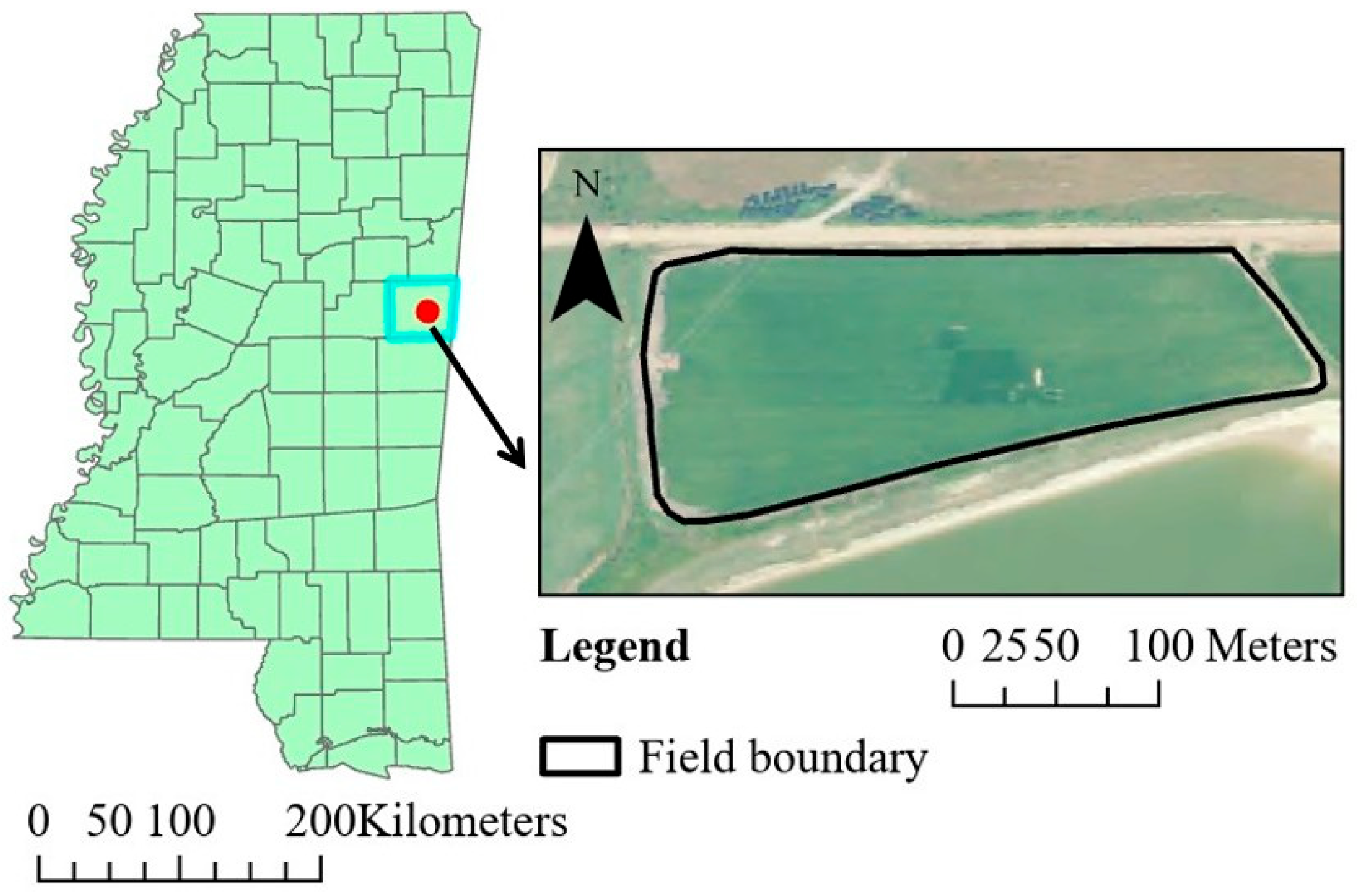
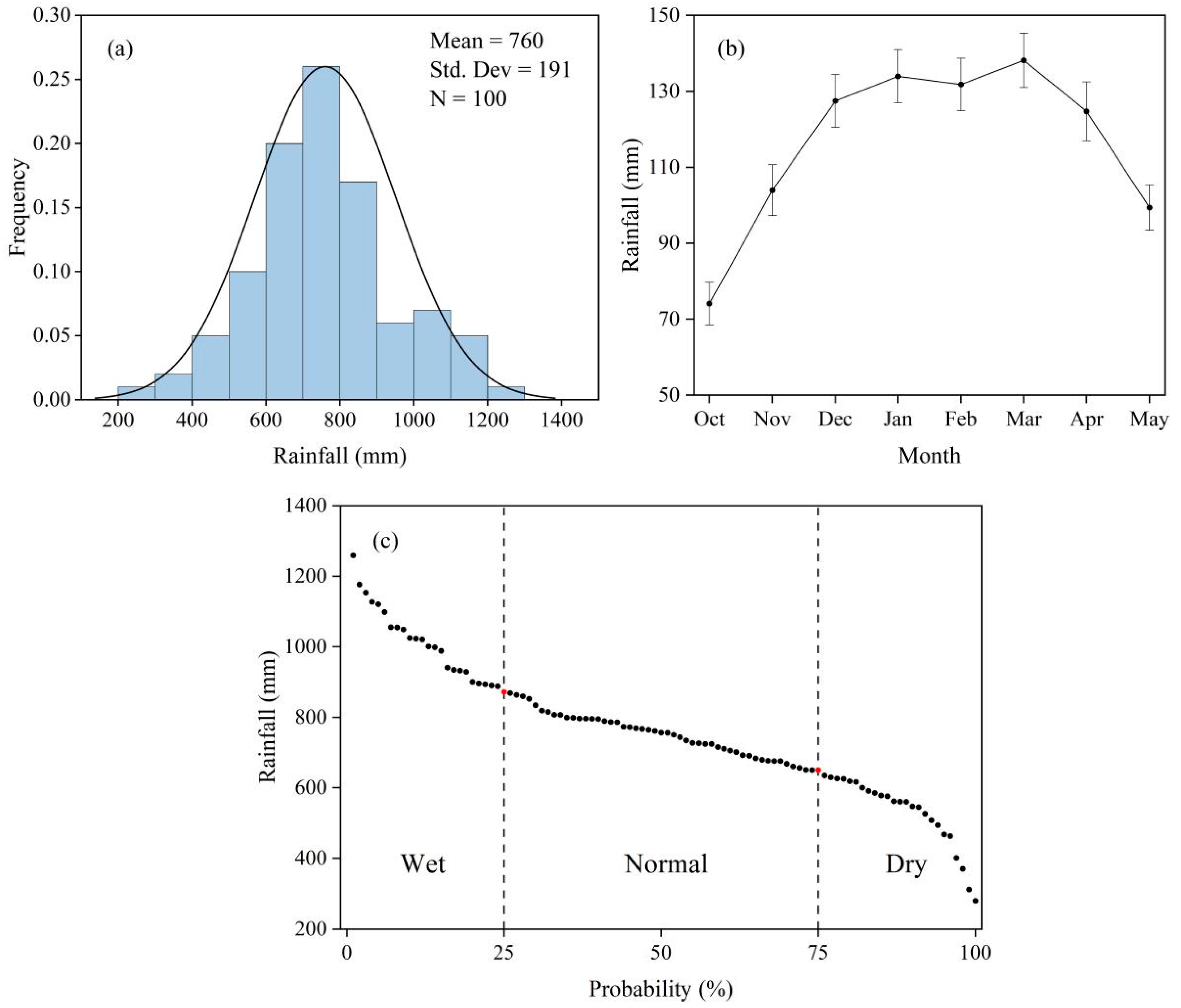
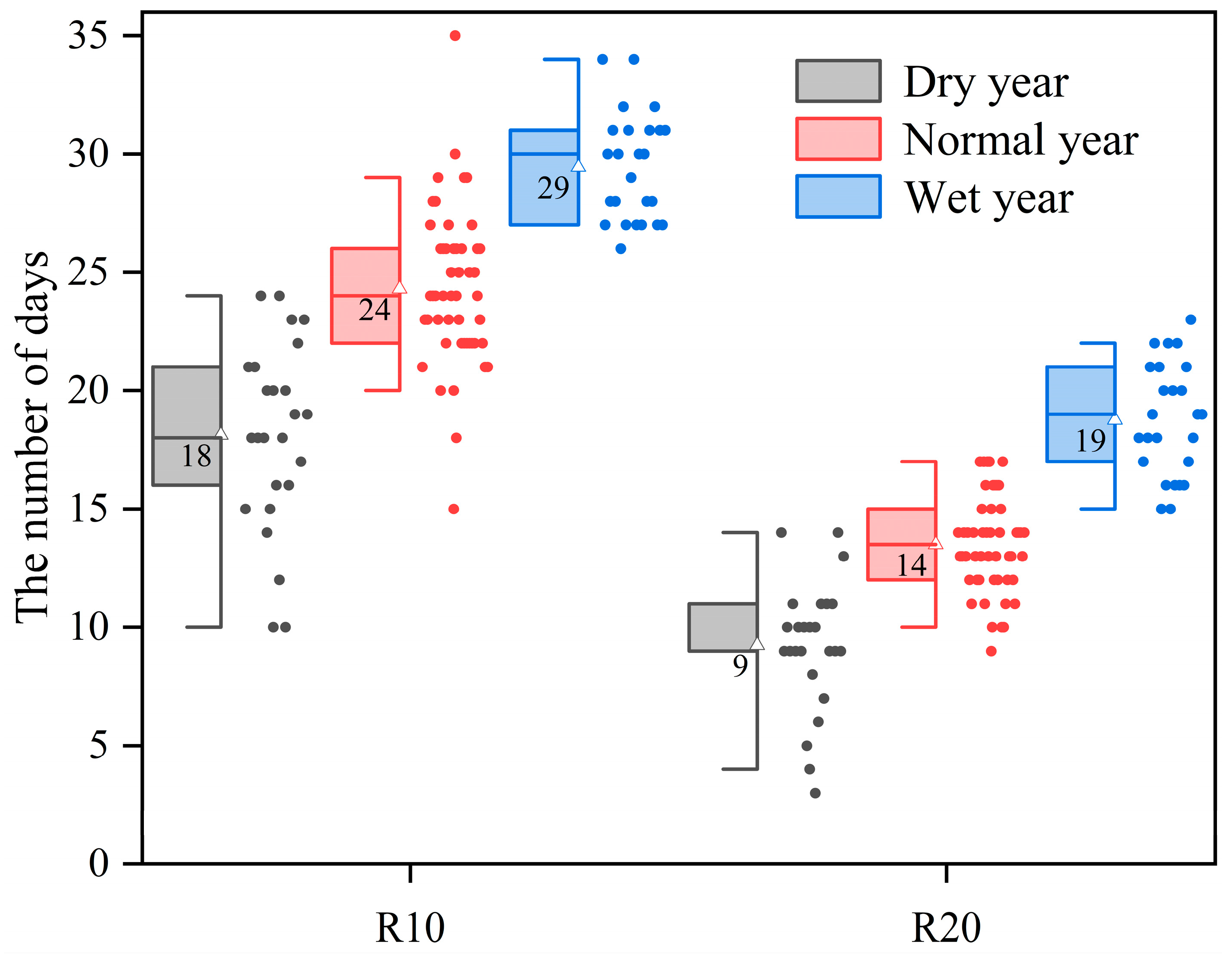


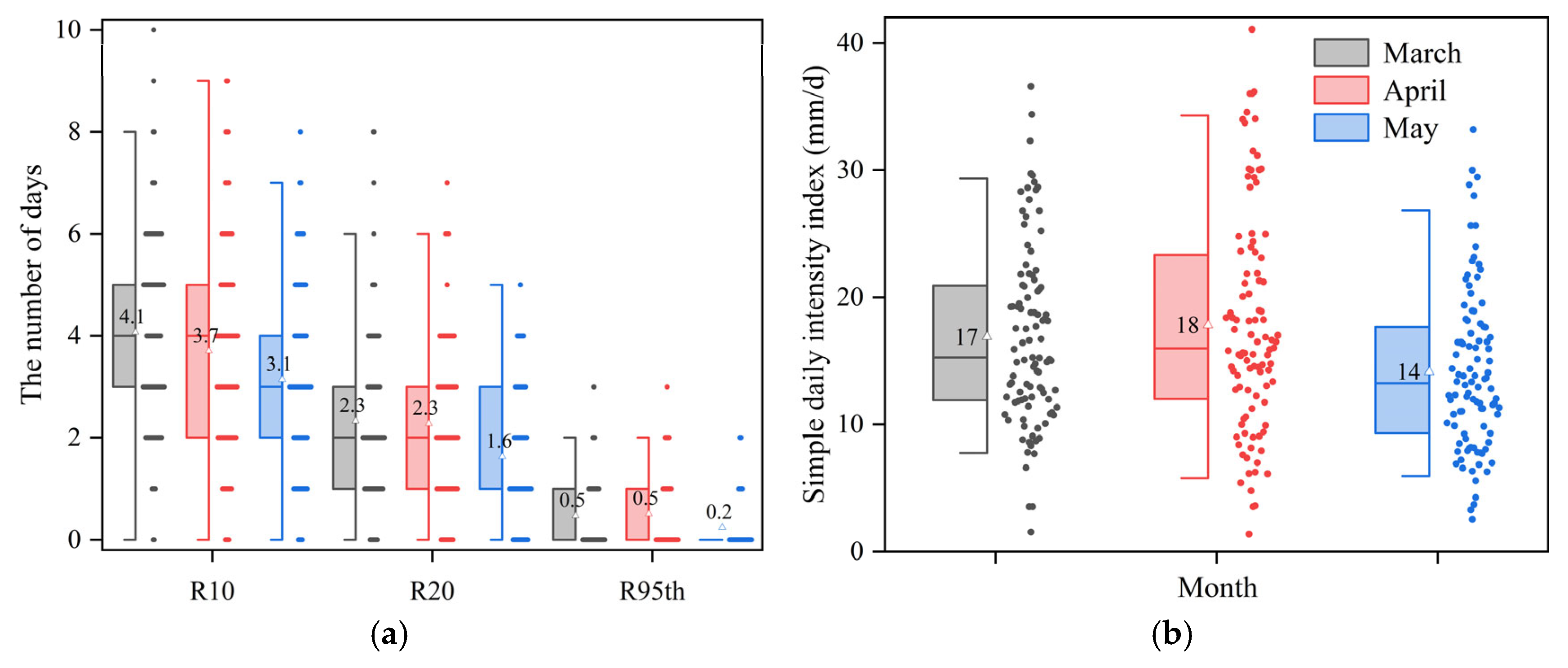
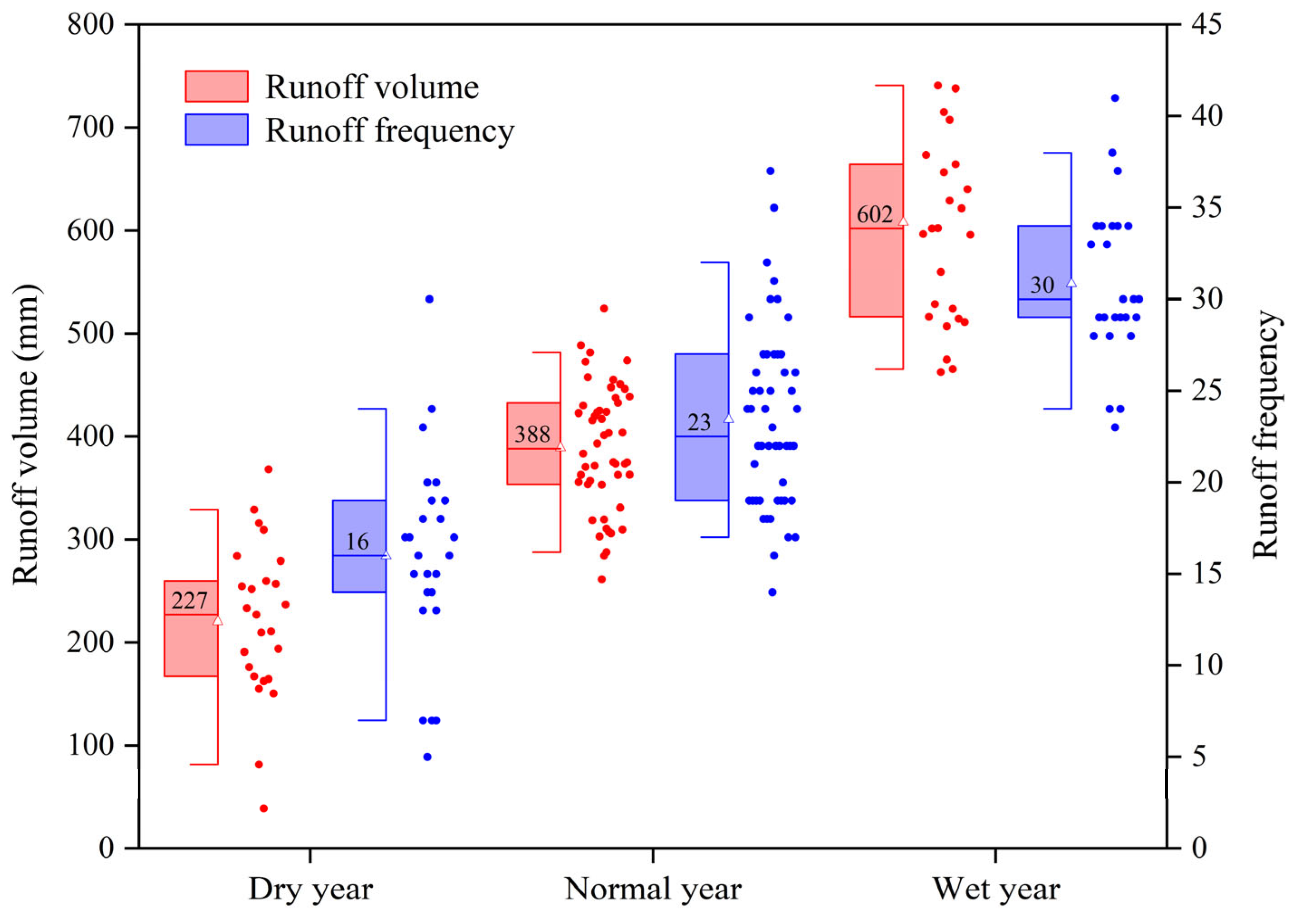
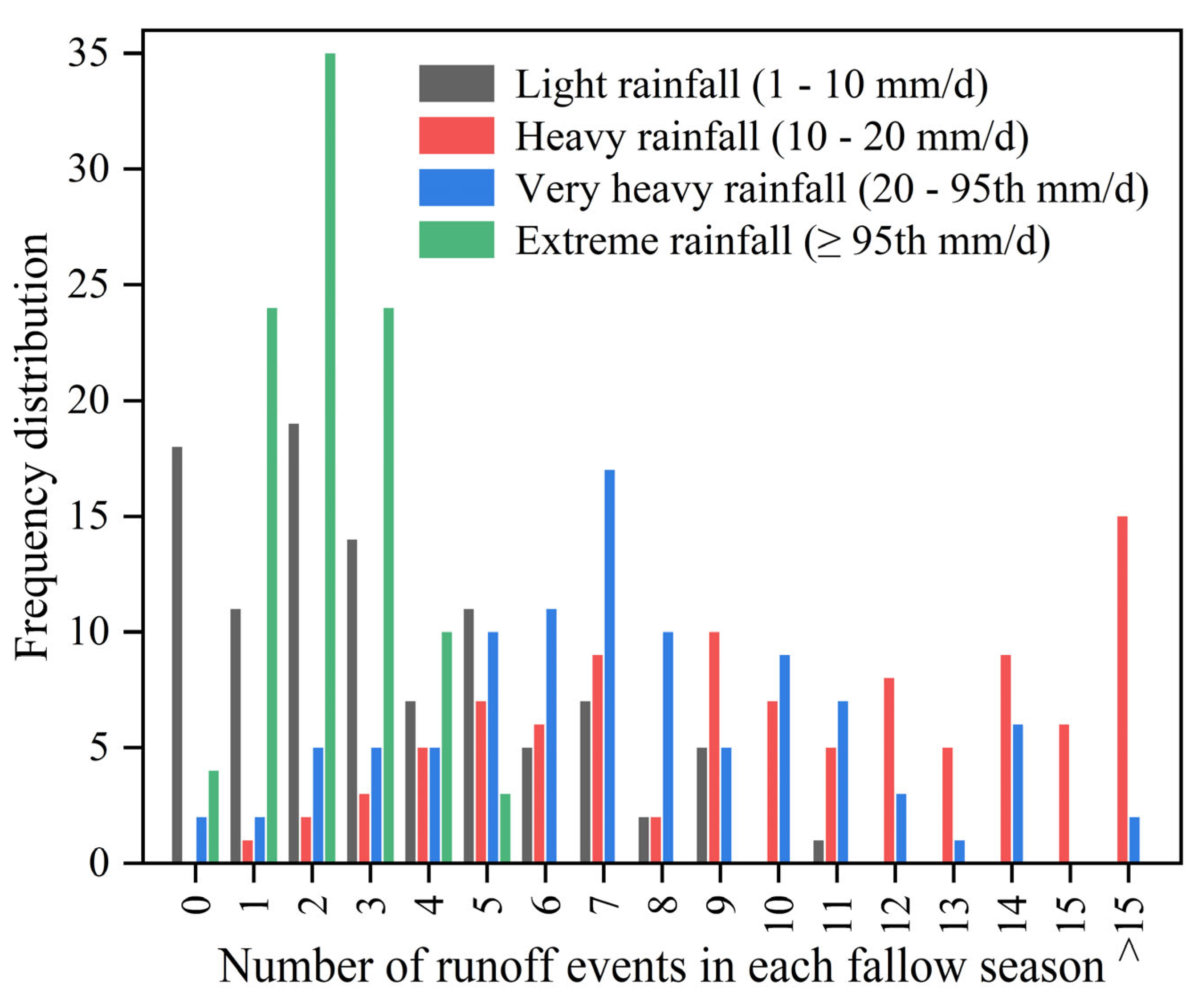
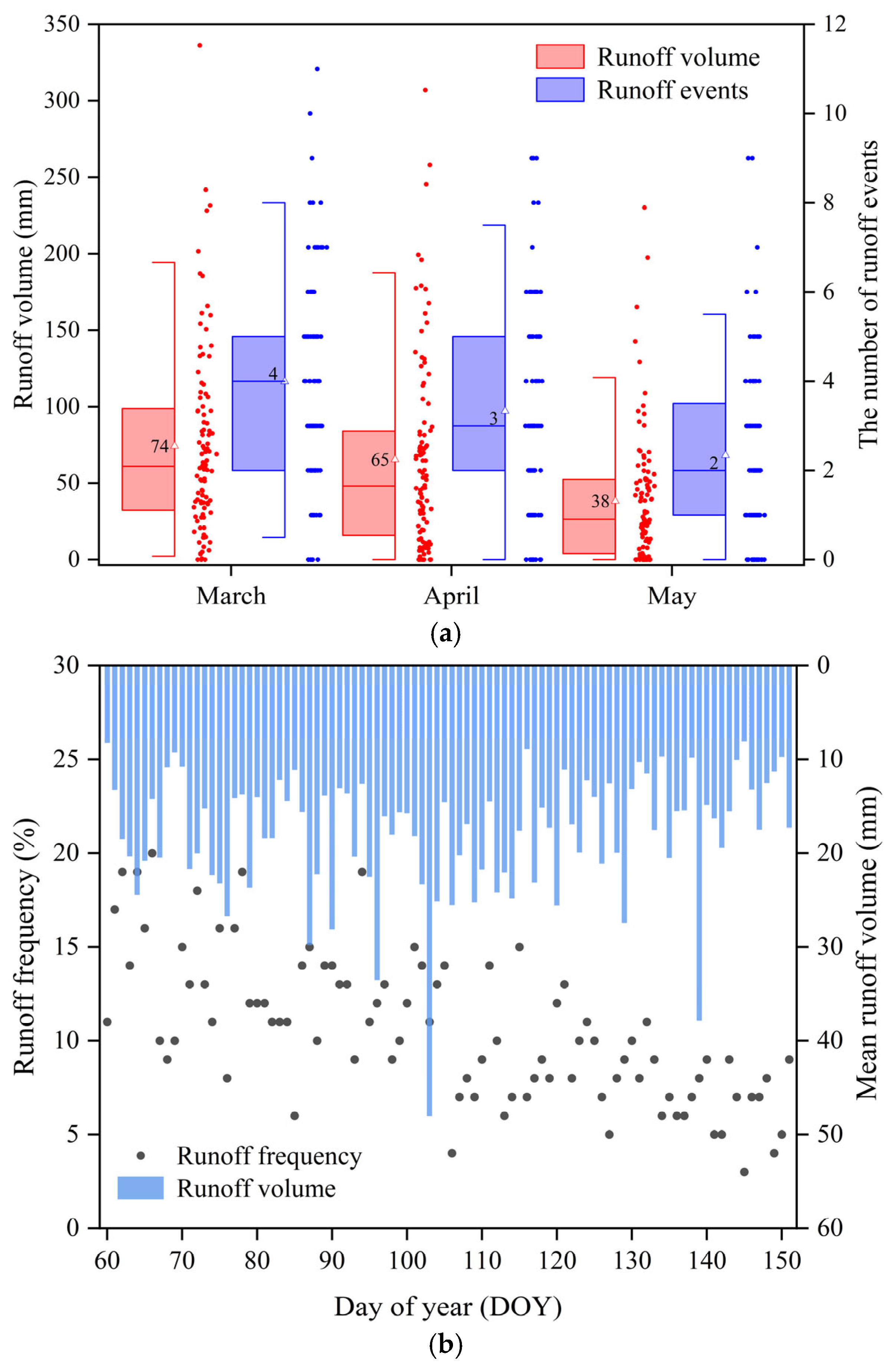

| Soil Layers | Bulk Density | Silt | Clay | Field Capacity | Wilting Point | Ks |
|---|---|---|---|---|---|---|
| (cm) | (g cm−3) | (%) | (%) | (cm3 cm−3) | (cm3 cm−3) | (cm d−1) |
| 0–15 | 1.35 | 51 | 41 | 0.45 | 0.22 | 0.86 |
| 15–30 | 1.42 | 22 | 68 | 0.44 | 0.35 | 0.60 |
| 30–150 | 1.41 | 23 | 69 | 0.44 | 0.35 | 0.94 |
| ID | Indicator Name | Definitions | Units |
|---|---|---|---|
| R10 | Number of heavy precipitation days | Annual count when precipitation ≥ 10 mm | days |
| R20 | Number of very heavy precipitation days | Annual count when precipitation ≥ 20 mm | days |
| R95th | Number of extreme precipitation days | Annual count when precipitation ≥ 95th percentile | days |
| SDII | Simple daily intensity index | The ratio of annual total precipitation to the number of wet days (≥1 mm) | mm/day |
| PRCPTOT | Annual total precipitation | Total precipitation from wet days (≥1 mm) | mm |
| R95p | Very wet days | Annual total precipitation from days (≥95th percentile) | mm |
| R95pTOT | Contribution from very wet days | R95p/PRCPTOT × 100 | % |
| Rainfall (mm/d) | Mean Rainfall (mm) | Mean Rainfall Frequency | Mean Runoff (mm) | Mean Runoff Frequency | Contribution to Total Runoff (%) | Runoff-to-Rainfall Ratio (%) |
|---|---|---|---|---|---|---|
| 1–10 | 96 | 21 | 11 | 3 | 3 | 11 |
| 10–20 | 147 | 10 | 37 | 6 | 9 | 25 |
| 20–95th | 351 | 11 | 215 | 11 | 53 | 61 |
| ≥95th | 165 | 2 | 135 | 2 | 34 | 82 |
| Month | Mean Runoff Volume (mm) and Contribution to Total Runoff (%) | |||||
|---|---|---|---|---|---|---|
| 10–20 mm/d | 20–95th mm/d | ≥95th mm/d | ||||
| Mean | Contribution | Mean | Contribution | Mean | Contribution | |
| March | 7 | 9 | 39 | 52 | 32 | 36 |
| April | 3 | 5 | 31 | 49 | 34 | 45 |
| May | 2 | 6 | 22 | 59 | 18 | 34 |
| Month | Mean Water Table Depth (cm) | Available Pore Space (mm) | Rainfall Threshold (mm) |
|---|---|---|---|
| Nov | 84 | 16 | 26 |
| Dec | 47 | 5 | 15 |
| Jan | 38 | 3 | 13 |
| Feb | 37 | 3 | 13 |
| Mar | 46 | 5 | 15 |
| Apr | 58 | 8 | 18 |
| May | 80 | 14 | 24 |
Disclaimer/Publisher’s Note: The statements, opinions and data contained in all publications are solely those of the individual author(s) and contributor(s) and not of MDPI and/or the editor(s). MDPI and/or the editor(s) disclaim responsibility for any injury to people or property resulting from any ideas, methods, instructions or products referred to in the content. |
© 2025 by the authors. Licensee MDPI, Basel, Switzerland. This article is an open access article distributed under the terms and conditions of the Creative Commons Attribution (CC BY) license (https://creativecommons.org/licenses/by/4.0/).
Share and Cite
Peng, R.; Feng, G.; Ouyang, Y.; Bi, G.; Brooks, J. Long-Term Rainfall–Runoff Relationships During Fallow Seasons in a Humid Region. Climate 2025, 13, 149. https://doi.org/10.3390/cli13070149
Peng R, Feng G, Ouyang Y, Bi G, Brooks J. Long-Term Rainfall–Runoff Relationships During Fallow Seasons in a Humid Region. Climate. 2025; 13(7):149. https://doi.org/10.3390/cli13070149
Chicago/Turabian StylePeng, Rui, Gary Feng, Ying Ouyang, Guihong Bi, and John Brooks. 2025. "Long-Term Rainfall–Runoff Relationships During Fallow Seasons in a Humid Region" Climate 13, no. 7: 149. https://doi.org/10.3390/cli13070149
APA StylePeng, R., Feng, G., Ouyang, Y., Bi, G., & Brooks, J. (2025). Long-Term Rainfall–Runoff Relationships During Fallow Seasons in a Humid Region. Climate, 13(7), 149. https://doi.org/10.3390/cli13070149








